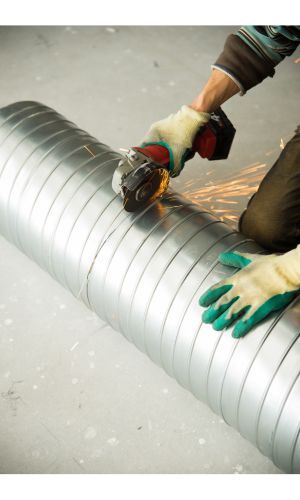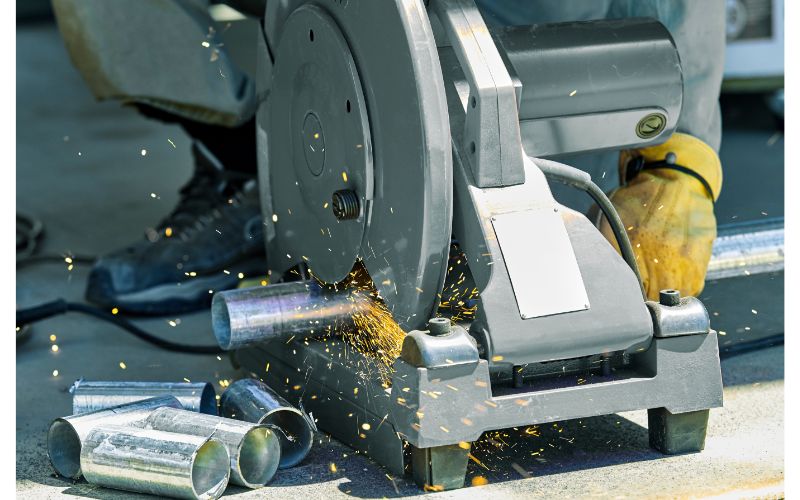Aluminum is a strong and lightweight metal that is highly resistant to corrosion, making it a popular choice for various applications. But cutting an aluminum pipe needs extra caution, equipment and knowledge.
So, how to cut Aluminum pipe? Cutting aluminum pipes is a straightforward process as long as you have the appropriate tools. First, you’ll need to measure and mark the pipe, then secure it with clamps before cutting. It’s crucial to take safety precautions and wear protective gear since aluminum can produce a lot of dust and debris.
This article provides a comprehensive guide on how to cut aluminum pipes, including the necessary tools and step-by-step instructions. Additionally, it covers safety measures and tips to enhance the cutting process.
Necessary Tools and Equipment Needed When Cutting Aluminum Pipe
Cutting aluminum requires various tools and equipment to ensure precision and safety. Some of these tools needed include:
1. Safety gear
The safety gear should include eyewear, gloves, a dust mask, and an apron. Aluminum can affect a person when breathed in, as stated under the hazardous substance fact sheet. Safety gear will protect you from sparks, debris, and inhalation.
2. Measuring tape
A measuring tape is needed to measure the aluminum pipe during cutting.
3. Marker
Like cutting other metals, you’ll require a marker to mark the position you want to cut after measuring. Marking helps prevent mistakes by cutting in the wrong position.
4. Deburring tool
Depending on the cutting tool, you may need a deburring tool to remove rough metal edges.
5. Clamps
You will need clamps to hold the aluminum pipe in position while cutting it to prevent damage.
6. Cutting tool
There are a variety of tools you can use to cut aluminum. However, the choice of the cutting tool to use depends on various factors, including;
- Pipe Thickness and Diameter: Larger diameter pipes and thicker pipes may require power tools, while the thinner and smaller diameter pipes use any cutting tool.
- Level of Precision Required: A power tool is ideal for cutting processes that require more precision. However, manual tools can be agreeable where precision is not an issue.
- Cut Smoothness: Some tools can make smooth cuts and are needed for projects that require you to cut the pipe smoothly.
And the cutting tools include:
❖ Hacksaw: A hacksaw is ideal when cutting small-diameter pipe as it is hand-powered and has a small-toothed saw.
❖ Miter saw: A miter saw is ideal when making precise cuts on a thick and large-diameter aluminum pipe. It’s a power tool that can be fitted with a variety of blades, including those compatible with cutting aluminum, like a 200-toothed HSS blade.
❖ Pipe Cutter: Pipe cutters are manual tools capable of cutting aluminum pipes with small and average diameters. This cutting tool is ideal for making precise and smooth cuts.
❖ Angle grinder: An angle grinder is another tool fit to cut aluminum pipe. This power tool can work fast but produces rough edges and may not make precise cuts.
How to Cut Aluminum Pipe: Step-by-Step
Once all the tools and equipment are ready, you are ready to start the cutting process. Follow the steps below to cut the aluminum pipe.
Step 1. Measure and Mark
The first step is to measure the aluminum pipe at the required points. Experts advise one to measure more than one time for accuracy. Use a marker to mark the cutting line. Some people prefer wrapping a tape instead of marking cutting points with a marker for better accuracy.
Step 2. Secure the Pipe
Secure the aluminum pipe with clamps to hold it in place once you start cutting. You may need multiple clamps when working on a long aluminum pipe.
Step 3. Wear Safety Gear and Choose your Tool
Wear safety gear to keep safe during the process. This is also an ideal time to choose the cutting machine to use. Also, use the slowest speed possible if your power tool’s blade speed is adjustable. Apply lubricant on the blades if you’re using a power tool to minimize sparks and prevent slippage.
Step 4. Cut
Cut through the marked part of the aluminum pipe with the cutting tool of your choice. It’s best to cut in one go for precision and accuracy. Move to the next marker and cut through if your pipe needs multiple cuts. In most cases, you may need to remove the pipe from the clamp.
Step 5. Deburr
Use a deburring tool to remove rough edges on the aluminum pipe. Deburring the edges of the aluminum pipe will leave it smooth and straight.
Step 6. Clean
Unclamp the aluminum pipe and clean it to remove the shavings on it before using it.
Precautions When Cutting Aluminum Pipe
There are various precautions to take when cutting aluminum pipes to ensure safety. They include;
- Wear Safety Gear
As mentioned above, wear safety gear, including a dust mask, to avoid breathing aluminum dust. Also, use eyewear to avoid getting aluminum fines into your eyes.
- Secure the Pipe
Ensure you secure the pipe tightly to prevent it from becoming loose while cutting, resulting in inaccurate cuts.
- Avoid Applying Too Much Pressure
Avoid applying excessive pressure on the tool since aluminum pipes are often easy to cut through. Too much force can damage the pipe or cause uneven cuts.
- Don’t Touch Edges
Avoid touching the aluminum pipe with your bare fingers before deburring it. Usually, the edges are sharp and contain burrs that can cut you when touched.
- Beware of fire
Avoid working in a room with fuel that can ignite from the sparks. Gasoline’s low flashpoint and high vapor density make it flammable and shouldn’t be in the room as it can ignite from a spark. Also, keep a fire extinguisher nearby in case the sparks ignite anything in the room.
Tips to Smoothen the Cutting Process
While aluminum pipe-cutting is not usually complicated, various tips can help make it even better. These tips include:
- Choosing an Appropriate Tool
Choose an appropriate tool to use when cutting to ensure precision and simplify the process. Use the aluminum pipe’s diameter and thickness to determine the right tool.
- Using Sharp Blade
Choose a sharp blade to prevent overheating since aluminum metals are more prone to overheating damage. A sharp cutting blade also contributes to precision and prevents uneven cuts.
- Using Cutting Fluid
As mentioned, cutting aluminum pipes using a power tool usually causes sparks. Use cutting fluid to minimize the sparks and improve accuracy.
- Cut Steadily
Cut steadily and slowly to ensure smoother and more accurate cuts on your aluminum pipe. Avoid haste or applying too much force on the machine while cutting.
Bottom Line
Cutting aluminum pipes requires precision due to the metal’s softness and sensitivity to heat. Several tools available, both manual and powered, can be used depending on the pipe’s diameter and thickness.
However, to ensure safety and success, following the steps outlined in the article and observing all necessary precautions is important. Additionally, the article provides helpful tips to make the cutting process smoother and yield better results.

